Clothes for newborns should be comfortable and practical. Parents are especially careful when choosing a winter wardrobe, and many of them prefer knitted overalls. This is a universal item that can be put on a child as the main clothing, or as an additional layer under an outdoor overall.
Selecting yarn
In order to knit a jumpsuit for a newborn baby yourself, you must first choose high-quality yarn.
Experts recommend choosing natural materials, as this reduces the risk of allergies. But this does not mean that synthetic fibers cannot be used. Acrylic yarn of various qualities is available on the market, and you can choose options with admixtures of natural fibers.
Knitted overalls for a newborn can be different depending on the season and the materials used to make it. Cotton threads are best for summer clothes, in which the child does not sweat and feels comfortable. Overheating is excluded in overalls made of this material.
For the winter period, combined yarn with acrylic and wool content in a ratio of 70% to 30% is most often chosen. Products made of 100% wool are, of course, warm, but can irritate the baby's delicate skin, be prickly and even cause allergies.
Advantages and disadvantages of different yarns used for children's things:
- Cotton.
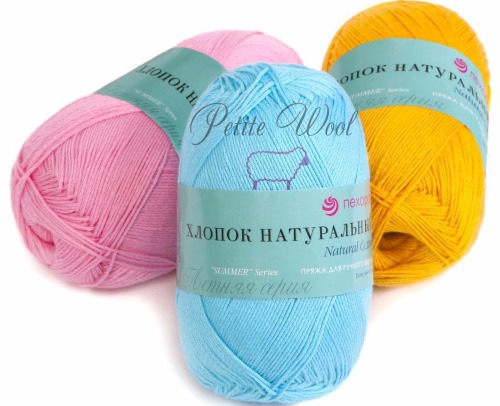
Advantages:
- Provides good heat exchange and also has high hygroscopicity.
- Natural thread that will not cause allergies.
- It has increased wear resistance.
Flaws:
- 100% cotton fabric may be too rough for baby's skin. You should choose either high-quality threads or those with acrylic added for softness.
- Items made from cheaper yarn may shrink significantly after washing.
- Cotton is not elastic, which affects the choice of model and pattern for knitting.
- Wool.
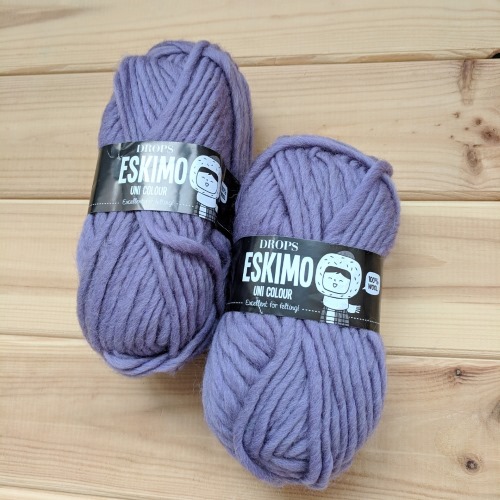
Advantages:
- Natural yarn, which is made from the wool of various animals, retains heat perfectly.
- Only hypoallergenic types of wool are selected for the production of children's yarn.
- It has antimicrobial properties and does not require frequent washing.
Flaws:
- Requires special care due to its tendency to severe deformation.
- The thread can become very fluffy, which is not acceptable for children's clothing.
- Some types of wool yarn can be prickly and irritate children's skin.
- Acrylic.

Advantages:
- All high quality acrylic is hypoallergenic.
- Products made from this material retain their shape perfectly and are ideal for everyday wear.
- Acrylic threads are easy to care for and tolerate intensive washing and the use of chemicals well.
- The products do not shrink.
Flaws:
- Yarn must be chosen very carefully, as often there are low-quality goods that do not have quality certificates.
- Acrylic fiber does not absorb moisture well, so if a child sweats in such a jumpsuit, he or she may catch a cold.
- Items made from this material can become highly electrified.
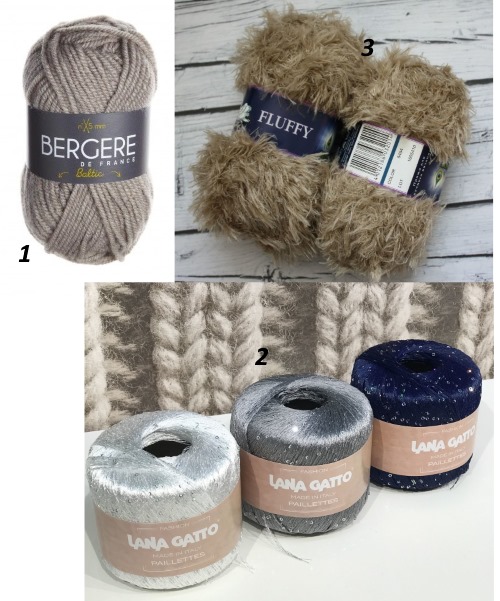
For a knitted jumpsuit for a newborn, you cannot use:
- Polyamide threads - is a synthetic yarn that is made from organic compounds such as oil or coal. It is absolutely not suitable for children's items.
- Long pile yarn – Children tend to put everything in their mouths, so using such threads is unacceptable. Long fibers can get into the respiratory tract and cause spasms.
- Threads with sequins or lurex – they make the product prickly and can injure the baby’s delicate skin.
Selection of model, color, patterns.
Knitted overalls for a newborn can be made in different models, based on the convenience of the child. For the smallest children, the best option is considered to be an envelope overall. It is easier to put on and it creates a cocoon effect that calms the child, creating the illusion that he is back in the womb. The main thing in such clothes is comfort.
Knitted jumpsuit for newborns - models:
- Transformer jumpsuit
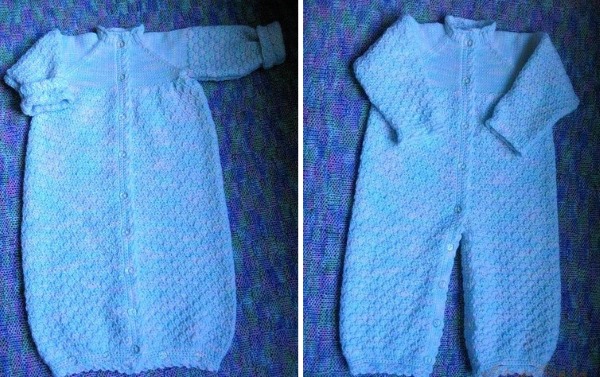
- Envelope jumpsuit
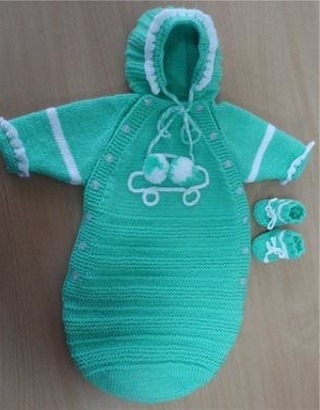
- Jumpsuit with straps
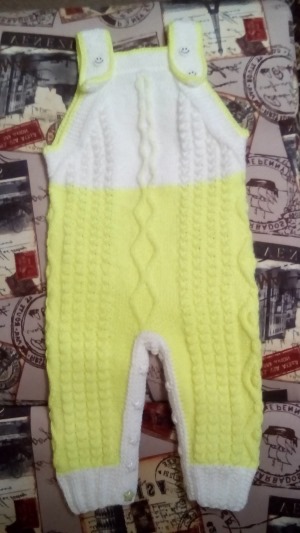
- Jumpsuit with a hood

- Overalls with a valve

For newborns, you need to choose simple patterns that will not make the product too voluminous and interfere with the child’s movement. Particular attention should be paid to the back of the product. It is better to choose flat patterns for it so that the child can lie comfortably.
Back Pattern Examples
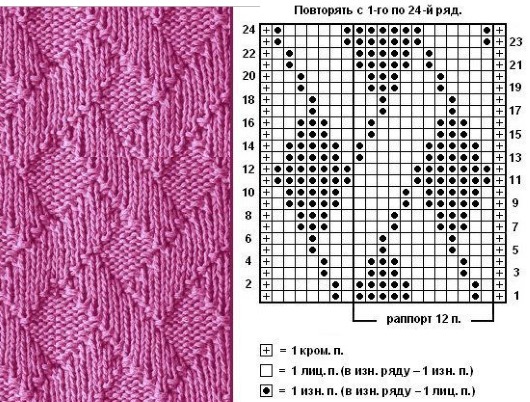
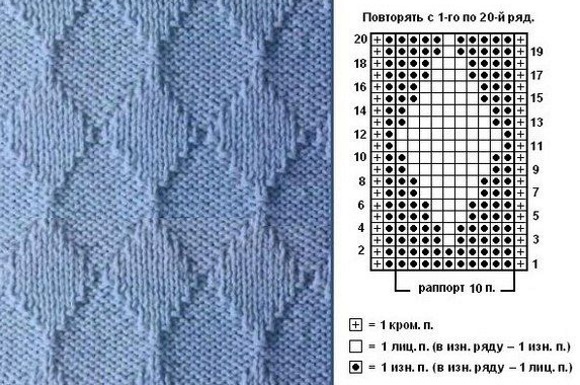


It has been proven that the level of perception in small children is much higher than in adults, so they react more positively to light and moderately bright shades. The youngest ones distinguish monochrome best.
Self-calculation
A knitted jumpsuit for a newborn can be a great gift for the birth of a child, but there may be difficulties with calculating the size. To do this, it is worth considering the average norms of height and weight of children.
Most often, children are born weighing about 3.5 kg and about 52 cm tall. These parameters correspond to children's size 56. The required sizes can be found in the corresponding tables. Using the table data and calculating the knitting density, you can knit a jumpsuit of any complexity.
Size chart for children in the first 6 months of life:
| 0-3 months | 1-3 months. | 3-6 months. | |
| Size | 56 | 62 | 68 |
| Height | 50-56 | 56-62 | 62-68 |
| Head circumference | 36 | 38 | 42 |
| Neck circumference | 22.5 | 23 | 23.5 |
| Chest circumference | 44 | 46 | 48 |
| Hip circumference | 46 | 48 | 50 |
| Sleeve length | 16 | 18 | 20 |
| Length from shoulder to waist in front | 14 | 16 | 18 |
| Length from shoulder to waist back | 16 | 17 | 18 |
| Length of trousers | 34 | 36 | 38 |
Selection of knitting needles and needles
You need to choose knitting tools based on the type of yarn you will be knitting the jumpsuit from, or more precisely, its thickness. Yarn labels indicate the yardage of the skein, its weight, and the recommended size of knitting needles or hook.
You also need to take into account the desired density of the fabric. If you need a voluminous and looser knit, you can take knitting needles 0.5-1 mm larger than recommended for the yarn.
And for elastic bands on cuffs, neck and other places, on the contrary, you need to use knitting needles 0.5-1 mm smaller. This will provide a denser knitting, which will hold its shape better.
To knit arans or braids, you need an additional knitting needle, which can be replaced with a regular hairpin. It is most convenient to knit such items on knitting needles with a fishing line. A pair with a fishing line of 60-80 cm is ideal.
For knitting sleeves and legs, it is best to use main size double pointed needles, as the diameter of these parts is small and it is difficult to knit them on needles with a cord.
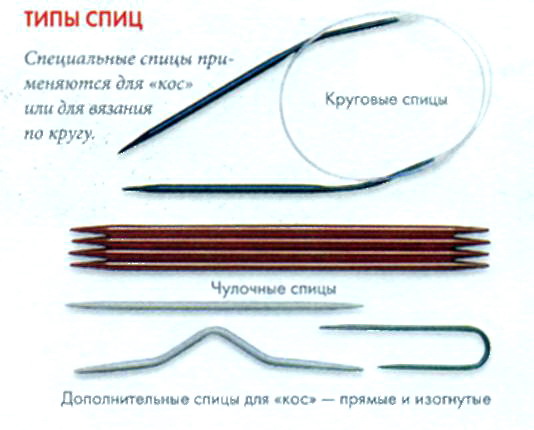
To close the loops on the edges of the product, you can use a hook or a thick needle. In cases where a more elastic edge is needed, for example on cuffs, a needle is preferable. If you want the edge of the strip to be even and not to tighten, then it is better to close the loops with a hook.
General recommendations for knitting
Experts advise following these rules when knitting overalls for babies:
- If the jumpsuit will use a complex pattern, it is better to first knit a sample of it with the same needles and yarn from which the product itself will be knitted and see how the thread behaves. If the sample is strongly deformed, this means that it will be necessary to provide for the addition of loops to align the product.
- The size of the jumpsuit for a newborn should be calculated with a small reserve, especially if it is a winter option. It should be taken into account that in the first months, children grow very quickly, so it is permissible to knit a thing even a size larger. But if the thing is too big, the baby may simply freeze in it, since it will not retain heat due to excessive volume.
Increasing the length of the body of the jumpsuit will allow it to fit the child better. These "extra" centimeters will be taken up by a diaper.
- The fittings for fasteners should be selected in advance and their location should be immediately determined. Most often, buttons and zippers are used for children's clothing. Snaps can only be used if the knitting edge is tight, otherwise the product will quickly deform from constant manipulation with them.
Knitting method from below
This method is suitable for beginner needlewomen, as it does not require complex calculations, as in the case of raglan. The details are knitted with the fabric unfolded, so if desired, you can use knitting needles without a line., the main thing is to follow the pattern and maintain symmetry.
One of the disadvantages of this knitting method is that such products have a lot of seams, which is not always good for a newborn baby.
Knitting method from above
This method is suitable for more experienced knitters, as it requires certain calculations and skills.
It is easier to start a knitted jumpsuit for a newborn from the top for ease of knitting and a reduction in the number of seams. Based on several basic values, which are easy to calculate, you can quickly calculate the required number of loops for knitting. With a certain amount of skill, calculating the raglan will not be difficult.
You only need to measure the neck circumference (hereinafter A). You also need to determine the knitting density. To do this, you need to take exactly those knitting needles and the yarn that will be used to knit the product, and knit a sample of ten loops, about 10 rows high.
Then calculate how many loops there are per centimeter of fabric - this will be the value B. For raglan lines, by default, 2 loops are taken, but their number can be any, depending on the pattern (hereinafter D).
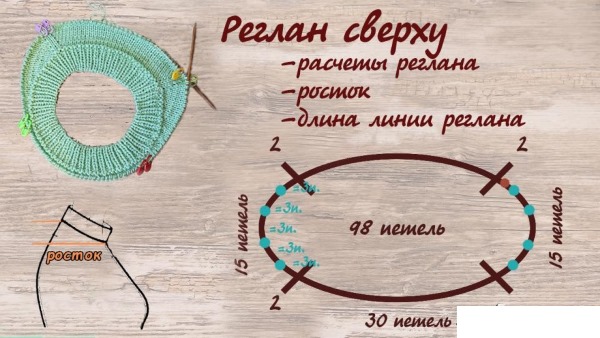
Then the calculation goes like this:
- A*B=C – we get the number of loops that need to be cast on to start knitting.
- C–D*4 = E – number of loops excluding raglan lines.
- E:3 = F – the number of loops that will go to the back/front and sleeves.
- To calculate the number of loops for one sleeve, you need to divide the F value by 2.
- The front of the product for knitting the jumpsuit will also need to be divided into 2 strips.
Simple jumpsuit for baby
Here is an example of the simplest jumpsuit for a newborn, which is knitted from the bottom up.
For work you need to take about 100 g of threads of the main color (in this case blue) and about 50 g of contrasting color (white) and about 30 g for piping. For work you can take children's acrylic with the addition of wool. You will also need 5-6 buttons or a zipper of the required length.
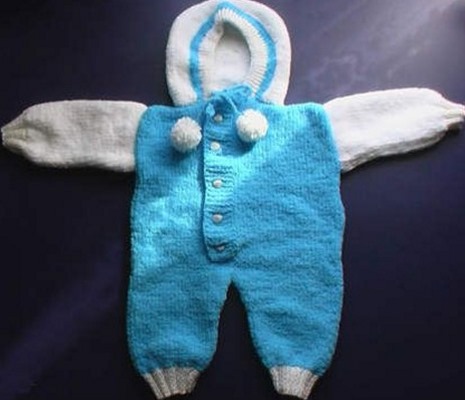
Work starts from the bottom of the trousers:
- First, the required number of loops are cast on with white thread on the main knitting needles on the fishing line. For the 56th children's size, you need about 40 loops, but it is better to knit a sample in advance and calculate how many loops are per 1 cm of fabric. Then the cuff of the leg is knitted with an elastic band. You can choose the 1x1 or 2x2 option. You will need to knit 10-15 rows.
- Once the elastic is ready, you need to switch to another color and continue knitting the leg with the front surface. As you knit, you will need to make even increases so that in the end you get 58 loops on the needle.
This is necessary to expand the fabric. Increases can be made in pairs or one loop at a time. After 50 rows have been knitted, the thread must be broken, leaving a long end. The second leg is knitted in the same way on the same needles.
- The legs are joined together, and then the whole piece of the overalls is knitted to the armhole line. On average, it is necessary to knit about 15 - 20 cm.

At this stage, you can start forming the placket if you plan to have a button fastening. But you can simplify the model and just sew in a zipper, for this you don’t need to knit the placket separately. You can also knit the placket separately along the edge of the product.
- Having reached the armhole line, the fabric is divided into 3 parts - two shelves and a back. The back usually takes 5-10 more loops than the shelves. The main thing is that there is an equal number of loops on the shelves, and on the back it can be odd. Each of the parts is knitted in turn up to the shoulder line.
- The sleeves can be knitted in several ways. You can knit them by picking up loops along the armhole line, you can knit the whole sleeves separately on double-pointed needles, or knit them in the same way as the pant legs were knitted, and then sew them together. In this model, the sleeves are knitted in the latter way.
For the cuff, about 36-40 loops are also cast on. After 10-15 rows of elastic, continue knitting the sleeve with the front surface of about 20-25 cm. It is necessary to make 12 increases, which should be evenly spaced. At the end, the sleeve is sewn and the second one is knitted similarly.

- The shoulder seams are made and then the sleeves are sewn in.
- The hood is knitted separately. 75 loops are cast on the knitting needles. About 5 cm are knitted with a 1x1 elastic band. Then another 30 rows are knitted with the front surface.
After this, the fabric is divided into three equal parts and knitting continues according to the pattern for knitting the heel of the sock - the central part is knitted with the capture of the outer loops from the other two parts. Knitting continues until the loops of the side parts run out. Then the finished hood is sewn to the product.
- All seams are finally checked, excess threads are removed, a fastener is made and additional decoration is added as desired.
Summer jumpsuit for girls
To work you will need approximately 250 g of cotton yarn 150 m/50 g, as well as circular knitting needles 2.5 mm and 3.0 mm, auxiliary knitting needles onto which individual parts will be transferred.
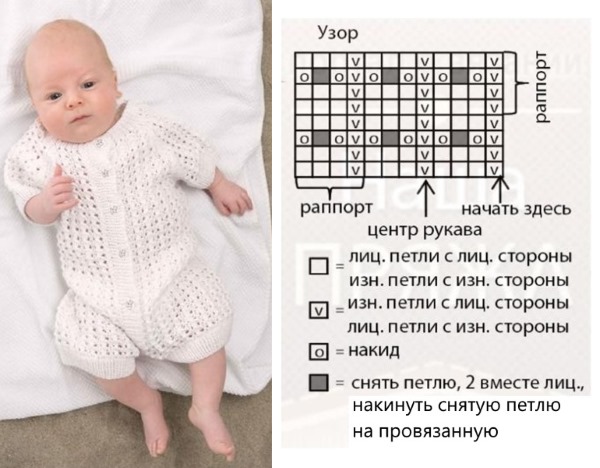
Work order:
- Knitting starts with the legs. On 2.5 mm knitting needles, cast on 58 stitches and close the knitting into a ring. Then knit 2 cm with a 1x1 elastic band.
After this, switch to larger knitting needles and knit a row of stocking stitch, adding loops evenly so that there are 64 of them in total. After this, switch to the pattern and knit 4 cm according to the diagram. Cut the thread, leaving a long end and throw the leg onto additional knitting needles. Knit the second leg in the same way.
- Transfer the first leg to the working needles and cast on 11 stitches between the legs and 150 stitches on the back. Place markers on the new stitches (4 pcs.). Close the knitting into a ring. Continue knitting according to the pattern, making decreases in the center of the back and front.
- You need to decrease according to the pattern: knit the entire pattern to the last loop before the marker on new loops, then remove the loop, knit one and throw the removed loop over it, then knit 9 knits, 2 together knits and repeat the same on the back. Continue decreasing until there are 2 knit loops left between them.
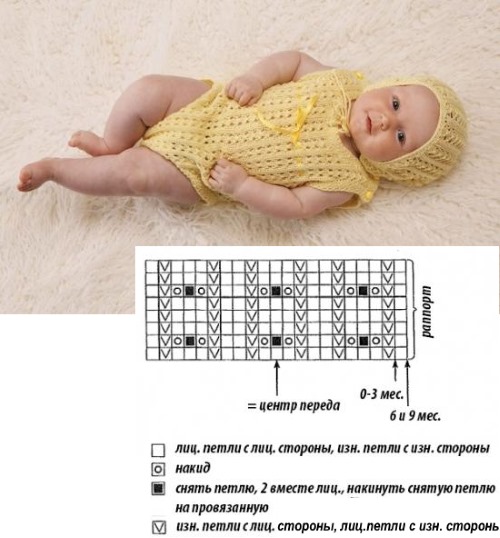
Slip all stitches and place markers at the center back and front. Then decrease as follows: knit the pattern to the last two stitches before the center marker at the front, then knit 2 together, pass the marker, slip the stitch, knit the next stitch and pass the slipped stitch over it. Repeat the same steps at the back.
Make decreases in every second row until there are 102 loops left. After that, close 5 loops in the center at the front (this should be the 3rd row of the pattern and should be closed with knit stitches), then continue knitting according to the pattern, turning the unfolded fabric back and forth.
After 31 cm of fabric has been knitted, place 2 markers, separating 23 loops of the shelves on both sides and 51 loops of the back. Close 5 loops for the armhole from the edges.
- Knit the sleeves separately. Cast on 36 stitches on 2.5 mm knitting needles and close into a ring, marking the beginning of the row with a marker. Knit 2 cm in ribbing and change to 3.0 mm knitting needles. Knit a row of stocking stitch with increases so that there are 41 stitches on the knitting needles. Then knit 8 rows of pattern according to the chart. Close 5 stitches on each side of the marker. Knit the second sleeve in the same way.
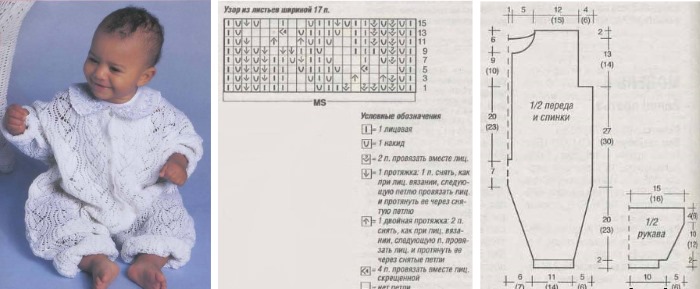
- Gather all the pieces on the main knitting needles so that the sleeve loops are located between the loops of the front and back. You should get 139 loops. Place 4 markers along the raglan lines. Knit in turning rows according to the pattern and simultaneously perform raglan decreases.
To do this, you need to knit the pattern up to the last 2 loops before the marker, then slip 1 loop, knit the next one and throw the slipped loop over it, throw the marker over, then knit 2 loops together and continue knitting according to the pattern.
Do these decreases on all 4 lines. In the end, there should be 59 loops left. After this, switch back to 2.5 mm needles and knit 2 cm with a rib pattern, then close the loops.
- Girls' overalls will be fastened on the left side. To do this, you need to knit the strips. On the left, cast on 76 loops on the front side using 2.5 mm knitting needles and knit 2 cm of elastic, then close the loops.
On the right side, also cast on 76 loops from the front and knit 4 rows with a rib pattern. Make 5 loops for buttons (close 2 loops and cast on 2 new ones above them). The first loop should be at a distance of 4 loops from the neck. Knit another 2 cm with a rib pattern and close the edge.
Winter jumpsuit for newborn
A knitted jumpsuit for a newborn is simply an irreplaceable thing. Most often, it is used as an undergarment under an outdoor jumpsuit or in a blanket. Therefore, it is important that such a jumpsuit is comfortable and does not have unnecessary seams. The ideal model is one that is knitted from above.
To work you will need about 250 g of wool yarn with an admixture of acrylic and 3.0 or 3.5 mm knitting needles, as well as 2.0 or 2.5 knitting needles for elastic bands:
- Calculate the required number of stitches using the raglan calculation formula and cast them on. Knit with a rib pattern for about 5 cm to form the collar.
After this, you need to use markers to mark 4 raglan lines. Usually they are 2 loops each and are separated by marks on both sides.
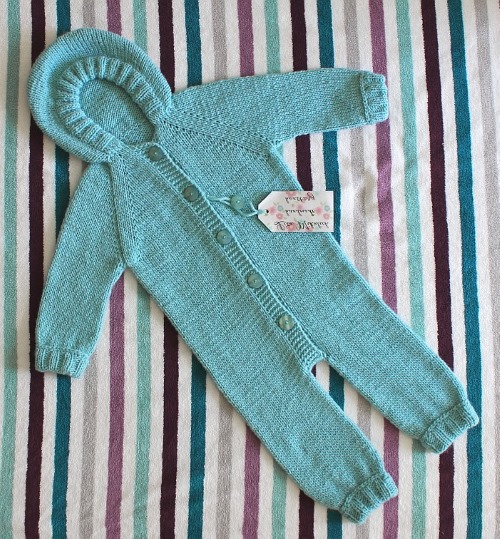
- Knitting continues according to the chosen pattern, and on both sides of the raglan lines, increases are made in each front row. Upon reaching the required armhole length, the sleeve loops are temporarily closed and small undercuts of 3-5 loops are made. Knitting continues as a single piece.
- When the desired length is reached, the knitting is closed into a ring and 3-5 more rows are knitted according to the pattern. Here you need to make calculations and if the number of loops is odd, then you should make one increase or decrease so that the number of loops becomes even.
- The resulting number of loops should be divided in half, these will be two legs. They can also be knitted without seams. To do this, the loops of one leg are dropped onto an additional knitting needle, and the loops of the other are closed into a ring - the first and last loops are knitted together.
Then knitting continues in a circle to the desired length. And at the end, knit about 5-8 cm with an elastic band on knitting needles 1 mm smaller than the main ones. The second leg is knitted similarly.
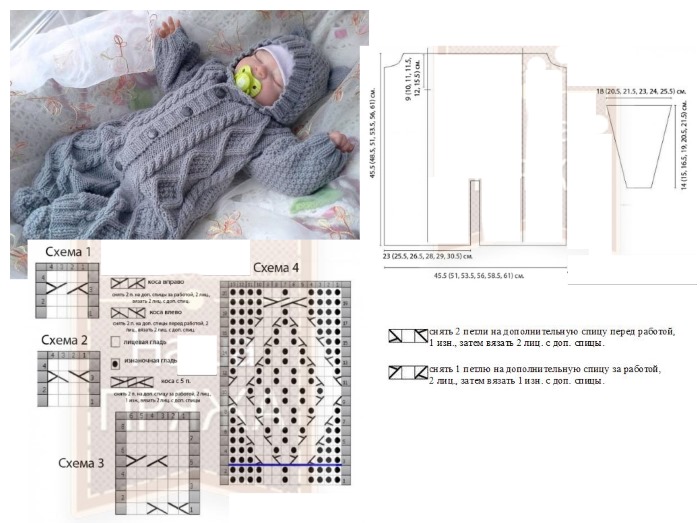
- The sleeve loops are opened and dropped onto the knitting needles, and the loops in the undercut area are also picked up. The sleeve is knitted in a circle. If desired, it can be narrowed by making decreases at the end and beginning of the circle. At the end, knit the cuff with an elastic band on knitting needles that are 1 mm smaller than the main ones and knit the second sleeve in the same way.
- The fastener can be made in the form of strips with buttons, or a zipper can be sewn in. But for newborns, the first option is preferable.
The strips are knitted on both shelves. To do this, the required number of loops are collected along the edge and knitted with about 3 cm of elastic. The strip with loops for buttons is made on the right or left, depending on who the jumpsuit is knitted for.
Openwork transformable jumpsuit
For work you will need 2.5 mm knitting needles on a fishing line and stocking needles, as well as a crochet hook. You can take any yarn, the main thing is that the thread thickness is 100 g / 350 m. You also need to choose suitable buttons or snaps for fasteners.
The first thing you need to do is decide on the size. Using the pattern sample, you need to find out how many loops there are per 1 cm. Then determine the overall width of the product so that the pattern repeat fits evenly on it. On average, the width will be about 30-40 cm, depending on the desired size. This means that the diameter of the trouser leg will be about 15-20 cm.
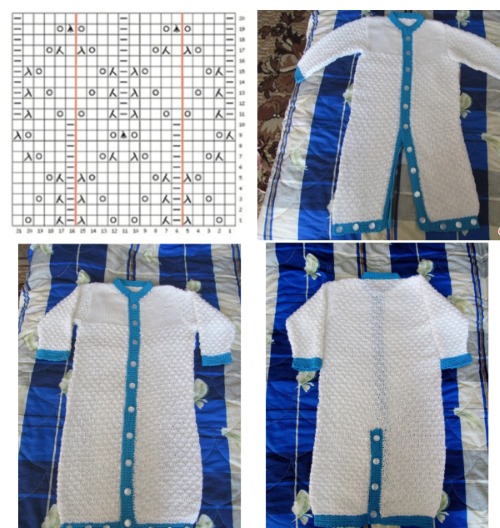
Knitting order:
- Cast on the required number of stitches and begin knitting a rectangle with the basic pattern so that its width is equal to the diameter of the leg, and the height is the desired length of the leg (approximately 20-25 cm). When finished, cut the thread, leaving a long end and knit the second leg in the same way.
- Place both legs on one working needle and join them into a single piece. Knit the main body of the overalls with the chosen pattern up to the armhole line. Then divide the fabric into 3 parts - 2 shelves and a back.
- Knit the back separately with the main pattern, and knit the fronts with the front surface. After that, sew the parts along the shoulder seam.
- Knit 2 sleeves separately. You can knit them either as a whole - without a seam, or as a piece of fabric, and then sew them together. When both parts are ready, they need to be sewn to the product.
- You need to knit the strips along the bottom of the overalls and along the shelves. The main thing here is to accurately calculate the location of the loops on the legs so that they match when you need to transform the cocoon into pants. The strips can be knitted with either knitting needles or a crochet hook.
- Sew on all buttons and make final decorations as you wish.
For growth
A knitted jumpsuit for a newborn is very practical, but small children grow very quickly, and the thing does not have time to serve them for a long time. When knitting a jumpsuit for a baby, you can go for some tricks that will allow you to wear it not for a couple of weeks, but for several months.
This is especially practical for children born in winter or autumn. A jumpsuit knitted for growth will serve them throughout the cold season.
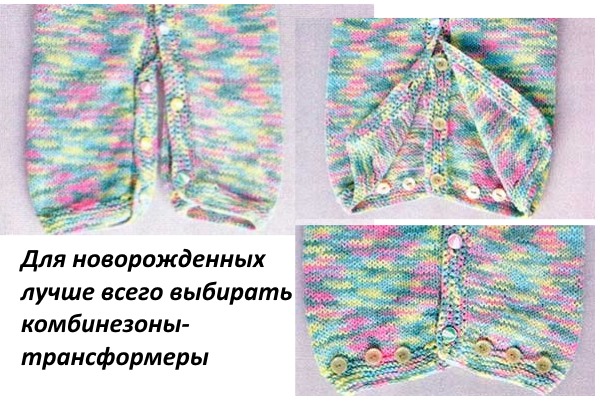
Tricks to make your knitted jumpsuit last longer:
- Use a transformer model. This is the most practical option, which will allow you to first use the jumpsuit as a cocoon, and then as a full-fledged suit with two legs.
- On the cuffs of the sleeves and legs, you can make a longer elastic band, which at first will have to be folded over, and then it will add 3-5 cm of length as the baby grows.
- If you knit the jumpsuit in the form of pants with suspenders, then due to this you can also use it for a long time, you will only need to re-sew the buttons on the fasteners.
- You can achieve a small size reserve due to the knitting pattern. If you use a vertical or horizontal elastic band, then they will allow you to wear the item longer.
- Initially, it is worth knitting the jumpsuit with a small reserve, counting on the fact that the child will grow. Just do not make it too big, otherwise it will not perform its main function - to keep warm.
A knitted jumpsuit for a newborn is a basic item for a child's wardrobe. It is practical, comfortable and easy to put on, which is important for a small child. Such a jumpsuit can also be a great gift for a birth or christening and will be especially valuable if made with your own hands.
Article formatting:Natalie Podolskaya
Video about knitting a jumpsuit for a newborn baby
Knitted jumpsuit for a newborn baby:
